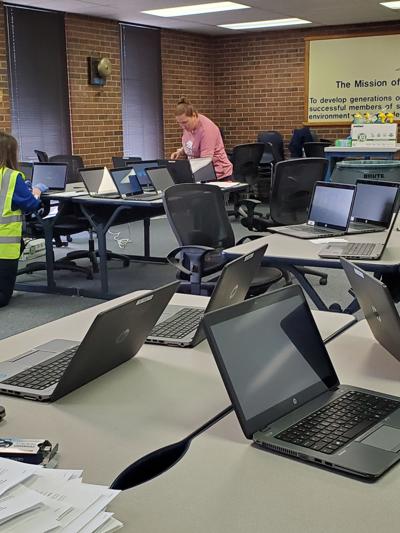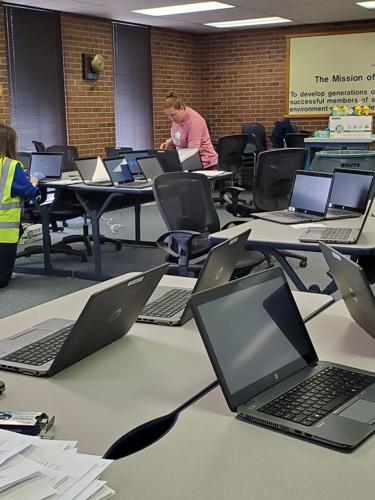A steep learning curve means some Pikes Peak region school districts are taking extra days to prepare for the new online learning necessitated by the coronoavirus pandemic.
“Obviously, it’s a thing in progress,” said Joe Schott, president of the Colorado Springs Education Association, the union representing Colorado Springs School District 11 teachers.
“We know families didn’t sign up for home-schooling or online learning, and we’re trying to connect with every family, come up with their needs, and figure out what that would look like at all the different schools — as opposed to a giant one-size-fits-all approach.”
- Where to get free lunch for students.
Providing instruction for all students without the physical space of a classroom has been challenging in several ways, officials say.
Instead of resuming classes immediately after spring break, D-11 designated last week as planning time for teachers and administrators, who called every family to determine students’ learning needs.
Surveys showed that the majority of the district’s 26,000 students prefer hybrid instruction models, with some students only able to access a laptop or other device for two hours or less a day.
Students were encouraged to continue their education this week without a formalized structure, Schott said, by working on existing assignments and projects, or looking at their individual graduate profiles to find something they wanted to learn and take steps to make it happen.
Not overwhelming students or families and not creating chaos at home while preventing academic backsliding are the goals, he said.
“Instead of going on quantity, the general idea is come up with ways to enrich and deepen learning, with student choice mixed in, so the learning is student-driven,” Schott said.
With the state lifting standardized testing requirements and suspending teacher evaluations and school performance measurements, the COVID-19 shutdown is an opportunity for students to “direct their own interests,” he said, “and for teachers to be a support,” instead of following the traditional classroom model.
“It doesn’t mean teachers aren’t coming up with exciting learning opportunities for students or adhering to standards, but we’re not chasing data points,” Schott said.
“This is not a re-creation of seat time at home behind a computer.”
The week has been difficult for some parents, though, including Taylor Love, the father of twins who attend D-11’s West Middle School.
“There’s still a lot of questions that as parents we just don’t have the answers to,” he said. “I understand it’s a very unusual situation, but there seems to be a lack of communication and a lack of a plan.”
Parents still haven’t been told how students will be graded or assessed, he said.
Love’s middle-schoolers used an Audubon Society Field Guide to identify trees in their neighborhood this week as one educational activity.
“We’ve been trying to keep them busy, but it’s hard,” he said. “I feel like the district should have figured it out by now.”
Students’ last day in class was March 13 for area public school districts, which had a preliminary run at distance learning the week before the scheduled spring break.
One of the struggles, said D-11 spokeswoman Devra Ashby, has been “how to get no-tech options in the hands of students.”
Paper materials may be mailed to students who have no or limited technology, or prefer paper and pencil work, Ashby said, for when online learning resumes on Tuesday.
D-11 is working on providing electronic devices to high school juniors and seniors, with the district already supplying devices to freshmen and sophomores. More devices have been ordered, Ashby said. They will need security protections installed before they can go out to students.
Already, the Schoology online learning platform that many districts use seems taxed and crashed this week, as did another called Seesaw.
D-11 extended Wi-Fi services to parking lots at some school buildings for teachers who needed internet access to have it this week, Ashby said. The district is considering equipping school buses with wifi connection and placing them in certain neighborhoods, she added.
Content primarily reviewing and reinforcing concepts
High school students in Harrison School District 2 started a remote learning model this week. All high-schoolers are issued laptops they can use at home, said spokeswoman Christine O’Brien.
Elementary and middle school students will resume classes Tuesday, with instruction focusing on language arts, reading, spelling, comprehension, writing and math for K-8.
The 10% of students who don’t have technology at home can obtain packets and workbooks during the free lunch giveaways at schools.
“We have technology in our schools, but it’s not enough to cover every child K-8,” O’Brien said. “Our plan is not to distribute a device to every child.”
However, the district has been “scrambling” to figure out how to obtain more devices, she said.
Teachers have called each student and are emailing and suggesting fun enrichment projects, O’Brien said.
“We’re not covering new content,” she said. “A lot of it is reteaching and practicing skills that have been learned in class.”
While schools want to ensure education continues, educators also are addressing social and emotional needs by providing free to-go meals, family groceries and other assistance, O’Brien said, because “we know kids can’t learn their best if their basic needs aren’t being met.”
Fountain-Fort Carson School District 8 decided right after schools closed in mid-March that it would need two weeks of professional development for teachers to learn the digital platform it’s using, said Lori Cooper, assistant superintendent of student achievement.
Classes begin Tuesday with the goal of “all students confidently progressing to the next grade level.”
Teachers are being reminded that remote learning cannot operate at the same level of intensity or instructional time as in-class learning and instruction, Cooper said, particularly secondary students who might be preparing for Advanced Placement and college-entrance exams.
Because of challenges families are facing with employment, uncertainty about the future and potential illness, D-8 students “will not be penalized in any way” during remote learning, Cooper said.
D-8 handed out more than 500 electronic devices last week to families and staff that needed them, developed plans for special-education and other populations of students, and instituted a system for families to obtain hard copies of school work if needed.
One of the biggest challenges, Cooper said, has been "the volume and quantity of electronic communication that has been required" for everyone to understand remote learning in a short amount of time.
Studying lessons learned
Lewis-Palmer School District 38 in Monument started remote learning for all students on March 31 and is providing 510 electronic devices and 50 hot spots to families who requested them, said spokeswoman Julie Stephen.
Resources are available on school websites, she said, and families have been asked to reach out to teachers and schools for specific needs.
Widefield School District 3 started Thursday, after preparing over spring break and notifying parents on March 26 that instruction would begin April 2, said spokeswoman Samantha Briggs.
“For us, distance learning looks different classroom to classroom, school to school,” she said. “Some classes and students are using online apps and programs, while others are getting hard-copy packets and instructional materials.”
Teachers at St. Mary’s High School in Colorado Springs prepared for just 12 hours before launching remote learning on March 16, took a week of spring break, then resumed on March 31.
That first week led to “many lessons learned,” said St. Mary's President Rob Rysavy.
"When we sent the students home on March 13, we told the teachers, 'Deliver education next week, we don't care how you do it, we'll standardize later.'
“That's what we did; school stayed in session, but things were not standard across the school. We're still not perfectly standardized, but we are better and continue to improve."
School leaders spoke with other schools across the nation to exchange ideas and best practices to “rapidly improve in some key areas,” he said.
The flexibility of the first few weeks gave way to more structure and routine for students, including en masse morning prayer, the Pledge of Allegiance, announcements and online daily Mass.
Students and parents requested more “live” time with teachers, so instructors have added more live video opportunities, along with emails, chat rooms, education software and recorded video instruction, Rysavy said.
“A good teacher who isn't a super techno genius will be a good teacher in distance learning once they have some tech training,” he said.
"We weren't 100% ready for distance learning, but we decided to commit to it and adjust as necessary," Rysavy said.
“If we had waited until everything was perfectly aligned, we'd still be waiting to start school up."








 Your Privacy Choices
Your Privacy Choices